-

人教版新目标初中英语九年级上册I like music that I can dance to教案
教学目标: 1. Express preferences2. Talk about one’s likes and dislikes and the reasons3. Learn to express one’s opinions 4. Learn to write a reply 语言功能: 1) Talk about one’s preferences, using t he relative clause2) Talk about people’s likes and dislikes and the reasons3) Talk about opinions语言结构: Relative clauses with that and who语言目标:What kind of music do you like?I like music that I can sing along with.I love singers who write their own music.We prefer music that has great lyric.重点词汇及短语:heart, photography, interest, class, whatever, miss, okay, expect, sweet, taste, itself, laboratory, cancer, increase, biscuit, main, care, prefer… to…, remind somebody of …, dance to, sing along with, be sure to, interest somebody, make somebody adj., to be honest, suit somebody, on display, catch up教学重难点:What do other people think of the different kinds of things? How to express one’s opinions? 学习方式:讨论,合作学习情感目标:通过本单元的学习,能提高学生的艺术鉴赏能力和审美情趣,并引导学生养成健康的饮食习惯。课时安排5课时第一课时:Section A: 1a-2c第二课时:Section A : 3a-4第三课时:Section B:1-2c, Self check2第四课时:Section B: 3a-4, Self check1第五课时:Self check ReadingI like music that I can dance to.

人教版新目标初中英语九年级上册I used to be afraid of the dark教案
内容提示1.本单元主要内容是学会used to结构。Used to +动词原形表示过去经常、以前常常,只用于过去式中,用来表示现在已不存在的习惯或状态。例如:They used to play football together.他们过去常在一起蹋足球。(现在不在一起踢了)2.used to的疑问形式和否定形式为Did you use to…?和I didn’t use to… 也可以用Used you to…?和I used not to…但现在多使用前者。例如:Did you used to swim in the river? 你过去常在河里游泳吗?I didn’t use to play the piano. 我以前并不经常弹钢琴。教学目标一、学习目标(Language Goal) 1.学会陈述自己过去常做的事情。2.学会陈述自己过去的爱好等。3.能够表达自己现在和过去在外表、性格、娱乐等方面的变化。4.能够表达朋友、家人等现在和过去的变化。二、语言结构(Language Structures) 1.I used to be short when I was young. 我年轻时个子很矮。 2. —Did you use to have straight hair? 你过去是直发吗?—Yes, I did. 是的。 3. —Did you use to play the piano? 你过去弹钢琴吗?—No, I didn’t. 不,我不弹。 4.I used to be afraid of dark. 我过去害怕黑暗。 5.I’m terrified of the snakes. 我害怕蛇。

人教版新目标初中英语九年级下册By the time I got outside, the bus had already left教案
Ⅰ. Teaching Aims and Demands1. Knowledge Objects(1) Key Vocabularyoversleep(2) Target LanguageWhat happened?I overslept. And by the time I got up, my brother had already gotten in the shower.2. Ability Objects(1) Teach the students to use the new words.(2) Train the students to narrate past events with the Past Perfect Tense.(3) Train the students' listening and speaking skills with the target language.3. Moral ObjectIt’s a good habit to go to bed early in the evening and get up early in the morning. So you’ll never be in a hurry in the morning.Ⅱ. Teaching Key Points1. Key Vocabularyoversleep2. Target LanguageNarrate past events with the Past Perfect TenseⅢ. Teaching Difficult Points1. Train the students to narrate past events with the Past Perfect Tense.2. Train the students to understand the target language in spoken conversation.Ⅳ. Teaching Methods1. Thinking of examples from the students' real lives.2. Making sentences by looking at the pictures.Ⅴ. Teaching AidA tape recorderⅥ. Teaching ProceduresStep I Revision1. Revise the language points in Unit 8.Ask some questions like this: What volunteer work would you like to do?Help the students to answer, I’d like to…/I love to…/I hope to2. Practice the dialogue in Activity 3c on page 62 again. Get students to role play the similar dialogues with the following.

人教版新目标初中英语九年级上册It must belong to Carla教案
一、Section A该部分有4个模块。第一模块围绕Whose volleyball is this? 这一话题展开思维( 1a)、听力(1b)、口语( 1c)训练;第二模块围绕上一模块中的话题进行听力( 2a-2b)、口语训练( 2c);第三模块继续围绕前两个模块中的“making inferences”展开训练。训练形式为阅读排序( 3a)和两人问答(3b);第四模块仍就上一话题展开讨论。二、Section B该部分有4个模块。第一模块要求根据图画和所提供的单词写出合理的句子;第二模块在听力( 2a-2b)和分角色口语训练( 2c)的基础上,继续进行“推测”训练; 第三模块围绕“Strange events in Bell Tower neighborhood”这一话题展开阅读( 3a)和写作(3b -3c)训练;第四模块以dream为话题展开小组活动。三、Self Check该部分有3个模块。第一模块以填空形式对所学词汇进行训练;第二模块就8个谚语展开阅读和讨论。

人教版新目标初中英语九年级下册Rainy days make me sad教案
1. 教材分析本单元以how do things affect you?为话题, 从颜色、天气、音乐、广告、产品等方面谈论了外界事物如何影响人的心情。要求学生掌握表达某物或某事给人带来的感觉、看法或影响等。共设计了四个部分的内容:Section A 该部分有4个模块:第一模块围绕Which restaurant would you like to go to?这一话题展开思维(1a)、听力(1b)、口语(1c)训练;第二模块围绕How does music affect you? 进行听力(2a-2b)、口语训练(2c);第三模块继续围绕how do colors in the restaurant affect you这一话题展开训练,训练形式为阅读和问题体验(3a)和小组活动(3b);第四模块仍就How do things affect you这一话题以调查的形式展开讨论。Section B该部分有4个模块:第一模块围绕产品广告对人们的影响这一话题以“配对”(1a)与“列举”(1b)两种形式展开训练;第二模块继续围绕How do things affect you? 进行听力(2a-2b)、口语对话训练(2c);第三模块围绕“Advertising”这一话题展开阅读(3a-3b)和写作(3c)训练;第四模块围绕How posters affect you这一话题以口语训练形式展开小组活动。

人教版新目标初中英语九年级下册Could you please tell me where the restrooms are教案
Step Ⅰ RevisionCheck homework. Ask a few students to read the article in 3a.Then ask a few students to read their guides.Step Ⅱ Part 1Look at the words in the box. Ask a student to read them. Make sure the students understand the meaning of the words. You are to fill in the blanks with the words. In some cases, students may need to use another form of the word, for example adjusting for tense or subject/ verb agreement.Ask students to fill in the blanks on their own.Check the answers. Step ⅢPart 2Go through the instructions with the class.Look at the example with the students.Ask students what the answer would be.Ask a student to read the question and answer it.Excuse me, could you tell me where the bank is, please?The bank is across the street from the shopping malt.Get students to complete the work in pairs.Check the answers. Ask a few students to read their questions.Step Ⅳ Just for Fun!Ask all the students to read the conversation. Ask: What is funny about this cartoon? Help students to explain. A Martian is a person from the planet Mars.There is no such thing as Martian food on Earth, and the clerk looks silly because he is trying to think of where there is a Martian restaurant.Invite some pairs of students to present this conversation to the rest of the class.Step Ⅴ Summary and HomeworkIn this class, we’ve done much writing practice using the key vocabulary words and the target language presented in this unit. After class, please finish the questions in 2 in your exercise books. Then finish the exercises on pages 47~48 of the workbook as well.The Seventh Period Ⅰ Teaching Aims and Demands1. Knowledge Objects(1) Key Vocabularyimage, adventure, jealousy, hero, crime, journey, brave, no longer, show interest in, take it easy, become interested in, plain looks(2)Text:Grown-ups like cartoons, too.2. Ability Objects(1) Fast-reading to get a general idea of the text.(2) Careful-reading to get the detailed information in the text.

人教版新目标初中英语九年级下册I’ll help clean up the city parks教案
Talk about offering help (P60)I’ll help clean up the city parks.A: I’d like to work ...B: You could help ...Talk about ways to tell people about the Clean-Up Day (P61)We need to ...We can’t ...I’ll ...Talk about the work the volunteers do (P62)These three students all volunteer their time to help other people.Somebody loves to ... / helps ... / plans to ... / wants to ...A: What do you like doing?B: I like ... A: What kind of volunteer work do you think I could do?B: You could ...1. 重点词汇advertisement, fix, repair, pleasure, blind, deaf, shut, carry, specially, fetch2. 认读词汇hunger, homeless, cheer, clean-up, sign, establish, major, commitment, elementary, veterinarian, coach, similar, call-in, strategy, disabled, organization, unable, support, appreciate, donation, part of speech, pronoun, adverb, preposition, conjunction, donate, Jimmy, Sally3. 词组clean up, cheer up, give out, put off, set up, think up, take after, fix up, give away, put up, hand out, work out, at once

人教版新目标初中英语九年级下册You’re supposed to shake hands教案
教学目标:1. 掌握本单元一些重点词汇的写法和用法。2. 学会自如谈论餐桌礼仪。Step 1 RevisionAsk some students to retell the customs at the table in France in the passage in 3a.Step 2 Self checkPart 1. Fill in each bland with the correct word given. Students do the exercises by themselves at first. Then check the answers. Ask the students to comprehend the sentences and help them point out uses of some words, like “arrive (at / in) sw., spend time / money on sth , spend time / money (in) doing sth.”Part 2. Read about Fan Ling’s experience in a western restaurant. Understand the passage. Point out some key points in the passage.1. be / get used to doing sth. 习惯做某事2. begin with = start with 以….开头3. crowd v. 挤满,塞满 the crowd 人群 crowded adj. 拥挤的Then students discuss about how she would solve her problem. Ask some to share their stories with others.Part 3. Complete the crossword by looking at the sentences on the left. Then check the answers.
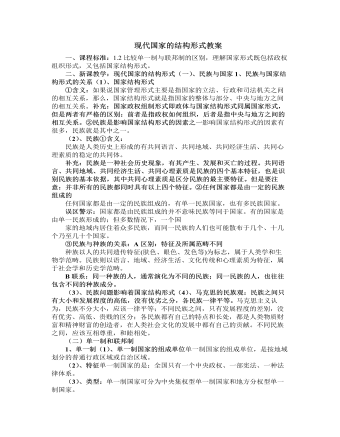
人教版高中政治选修3现代国家的结构形式教案
一、课程标准:1.2比较单一制与联邦制的区别,理解国家形式既包括政权组织形式,又包括国家结构形式。 二、新课教学:现代国家的结构形式(一)、民族与国家1、民族与国家结构形式的关系(1)、国家结构形式①含义:如果说国家管理形式主要是指国家的立法、行政和司法机关之问的相互关系,那么,国家结构形式就是指国家的整体与部分、中央与地方之间的相互关系。补充:国家政权组制形式即政体与国家结构形式同属国家形式,但是两者有严格的区别:前者是指政权如何组织,后者是指中央与地方之间的相互关系。②民族是影响国家结构形式的因素之一影响国家结构形式的因素有很多,民族就是其中之一。(2)、民族①含义:民族是人类历史上形成的有共同语言、共同地域、共同经济生活、共同心理素质的稳定的共同体。补充:民族是一种社会历史现象,有其产生、发展和灭亡的过程。
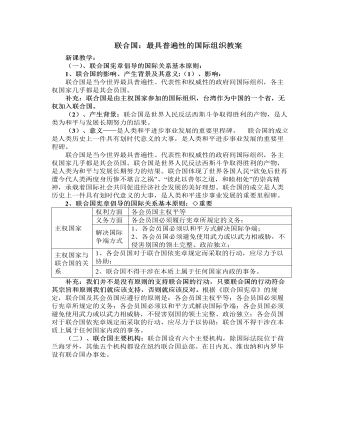
人教版高中政治选修3联合国:最具普遍性的国际组织教案
相关链接:联合国推动达成的部军控和裁军条约有:《南极条约》(1959年)、《外层空间条约》(1966年)、《不扩散核武器条约》(1968年)、《海床公约》(1970年)、《禁止生物武器公约》(1971年)、《月球协定》(1976年)、《禁止化学武器公约》(1992年)、《全面禁止核试验条约》(1996年)。2、推动共同发展、促进人类文明——经济方面联合国在经济和社会领域建立了一套庞大、复杂、较为系统的机构即联合国经社系统。经社系统制定指导性原则、政策框架以及行动纲领,规范国际社会各成员的行动方向,推动某些发展问题逐步得到解决。经社系统主持召开重大国际会议,从战略高度协调国际社会的经济和社会发展活动。联合国千年首脑会议制定了千年发展目标,为国际发展合作确立了路线图和时间表。经社系统长期从事开发活动,向有关国家提供发展所需的资金、技术,并帮助制定合适的发展战略和政策,为世界特别是发展中国家的经济社会发展作出了积极贡献。在解决全球环境问题方面,联合国做了大量开创性工作。
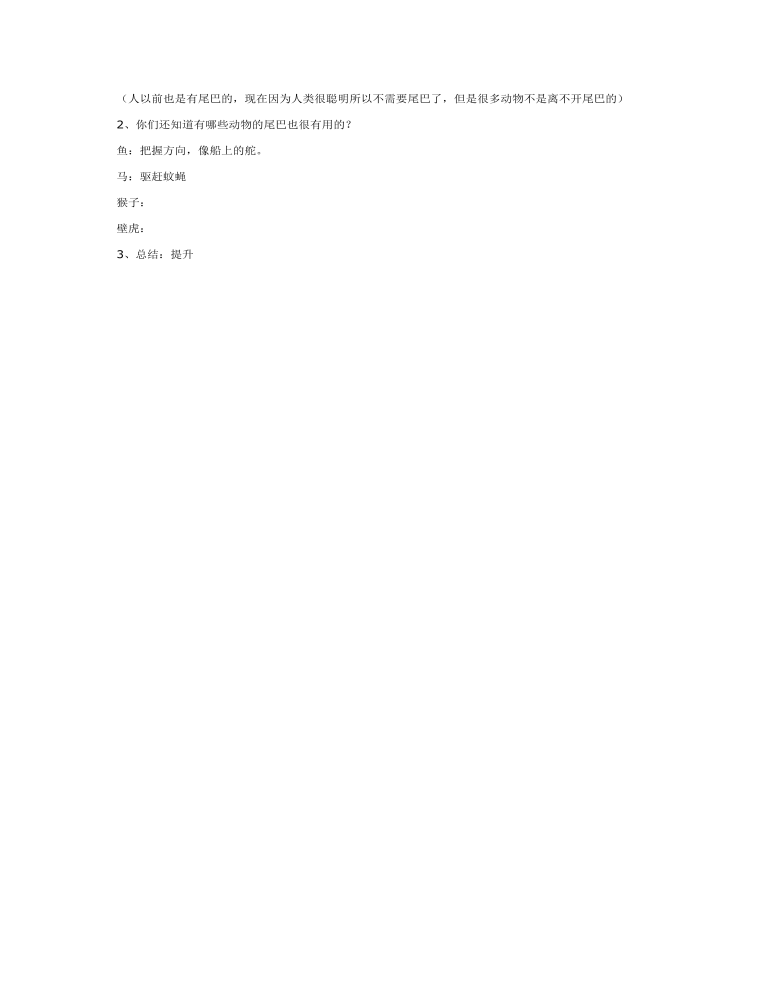
大班科学课件教案:动物的尾巴2
活动过程:一、游戏“猜尾巴”1、今天本来有很多动物朋友来跟我们做游戏,但是它们很淘气,要和我们捉迷藏,让我们来找它。出示各种动物的图片(遮住身体露出尾巴)2、这些动物太粗心了,把头和身体藏了起来,可是什么露出来了?——尾巴3、哎!尾巴在外面我们就能猜出它是谁?谁来猜猜看。——这是马的尾巴,因为马尾巴是长长的,像……——这是豹子尾巴,因为它身上有斑点出来吧,我们猜出你是谁啦!小结:每种动物都有尾巴的,而这从它的尾巴的不同,我们就猜出它是谁。
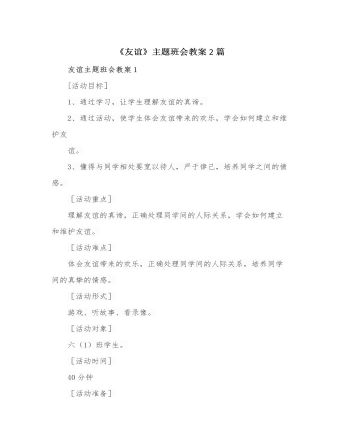
《友谊》主题班会教案2篇
三、动笔写一写为你的朋友写下一句发自内心的祝福或者写上一句真诚的“对不起”,找个机会交给他(她)??1、学生练写2、指名回答。3、学生交换卡片。四、游戏:你比我猜默契大考验学生游戏,评比出最默契的一组五、听故事《朋友,我就知道你会来》1、听故事。2、学生齐读《真正的朋友》六、全班合唱歌曲《朋友》,结束课题。友谊主题班会教案2教学目标:1.通过本次班会活动,增进学生之间的相互了解,增进友谊,营造良好的班集体氛围和学习氛围。2.让学生学会换位思考,学会为别人着想,发现并学习别人身上的优点,学会关心别人,学会信任别人,学会团结同学,提高班集体的凝聚力。教学重、难点:增进学生之间的相互了解,增进友谊,营造良好的班集体氛围和学习氛围。学会团结同学,提高班集体的凝聚力。教学过程:
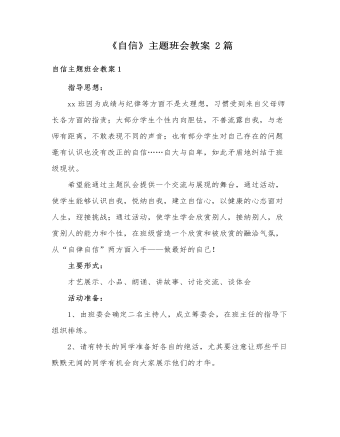
《自信》主题班会教案 2篇
5、班委、同学发言讨论,怎样做最棒的自己——我们每个人都是立体多面的。正所谓,金无足赤,人无完人。学会以正确的方法去评价他人,同时应该积极树立起自信心,自信自律就一定能塑造最好的自我6、年度风云人物“top10个性学生”评选——在充满自信与欣赏的氛围中,对今后的努力方向提出要求与设想,相信我们的学生富有各自的个性特点,在不断的努力中一定能做到今天比昨天好,明天又会比今天好,在成长的不断超越,让自信的生命变得更加多姿多彩。自信主题班会教案2活动目的:1、通过本次活动,让学生了解自信在自己的学习、生活中的重要作用,引导学生的心理向健康方向发展,正确看待生活中的正确与失败。2、使学生掌握树立自信心的方法,不断调整自己,树立自信。活动准备:1、搜集有关自信的故事。2 、学生准备才艺表演、
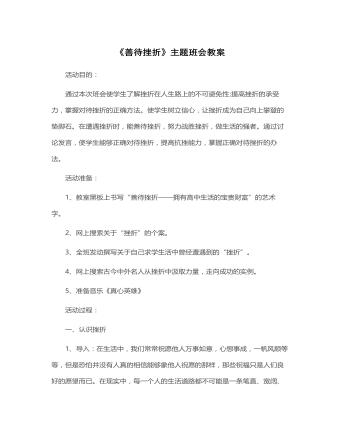
《挫折》主题班会教案2 篇
3.学生讨论(1)扎曼是怎样离开可口可乐公司的?(2)扎曼离职时是什么心情?他的信条是什么?师:从扎曼的例子看,挫折,不论是人格上使人蒙受屈辱的,还是破坏个人形象的,有时并不像人们想象的那么糟糕。扎曼能在7年后杀回可口可乐公司,重塑形象,并且事业蒸蒸日上,其他人也可以象他一样,不怕失败,敢冒风险,相信失败的境遇会有改观。二、感受挫折2.谈谈同学自己所经历的一些挫折师:每个人都有他自己的人生理想,有一个奋斗的目标。有志者总会不断地努力,向着自己的人生目标迈进,但在奋斗的过程中,总难免遇到这样或那样的挫折,挡住你前进的脚步。在这种情况下,人们就会产生不安、失意等情绪体验,并伴随着相应的外部行为反应,这就是挫折。
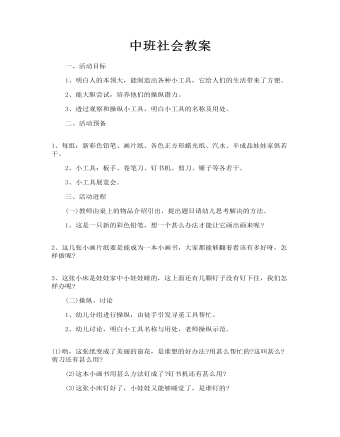
中班社会教案
二、活动预备 1、每组:新彩色铅笔、画片纸、各色正方形蜡光纸、汽水、半成品娃娃家俱若干。 2、小工具:板手、卷笔刀、钉书机、剪刀、锤子等各若干。 3、小工具展览会。 三、活动进程 (一)教师由桌上的物品介绍引出,提出题目请幼儿思考解决的方法。 1、这是一只新的彩色铅笔,想一个甚么办法才能让它画出画来呢? 2、这几张小画片纸要是能成为一本小画书,大家都能够翻着看该有多好呀,怎样做呢?
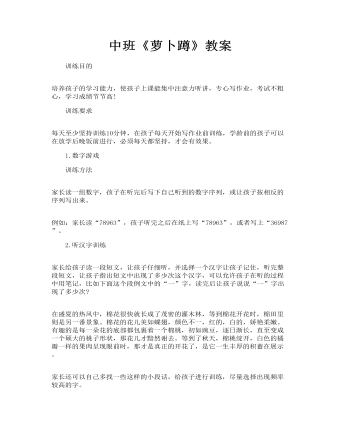
中班《萝卜蹲》教案
1.数字游戏 训练方法 家长读一组数字,孩子在听完后写下自己听到的数字序列,或让孩子按相反的序列写出来。 例如:家长读“78963”,孩子听完之后在纸上写“78963”,或者写上“36987”。 2.听汉字训练 家长给孩子读一段短文,让孩子仔细听,并选择一个汉字让孩子记住,听完整段短文,让孩子指出短文中出现了多少次这个汉字,可以允许孩子在听的过程中用笔记,比如下面这个段例文中的“一”字,读完后让孩子说说“一”字出现了多少次?
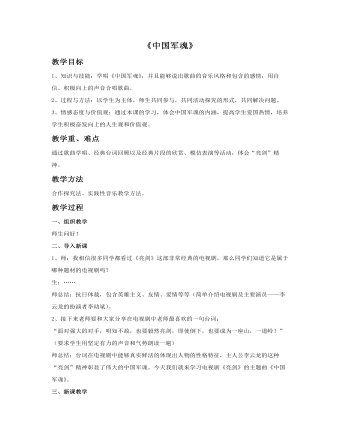
《中国军魂》教案
教学过程一、组织教学师生问好!二、导入新课1、师:我相信很多同学都看过《亮剑》这部非常经典的电视剧,那么同学们知道它是属于哪种题材的电视剧吗?生:……师总结:抗日体裁,包含英雄主义、友情、爱情等等(简单介绍电视剧及主要演员——李云龙的扮演者李幼斌)。2、接下来老师要和大家分享在电视剧中老师最喜欢的一句台词:“面对强大的对手,明知不敌,也要毅然亮剑,即使倒下,也要成为一座山,一道岭!”(要求学生用坚定有力的声音和气势朗读一遍)师总结:台词在电视剧中能够真实鲜活的体现出人物的性格特征,主人公李云龙的这种“亮剑”精神彰显了伟大的中国军魂。今天我们就来学习电视剧《亮剑》的主题曲《中国军魂》。三、新课教学1、完整聆听第一遍歌曲,有感情的朗读歌词,引导学生分析作品音乐情绪、风格、演唱形式。(四四拍、中速、进行曲风格、男声合唱)2、介绍电视剧音乐相关知识。3、教师范唱。4、教唱歌曲。5、学生跟着音乐有感情的合唱歌曲.四、音乐实践表演活动1、《亮剑》经典片段欣赏与模仿——李云龙舍妻炸城楼。人物:李云龙、秀芹、和尚、日本军官……地点:城楼事件:新婚期李云龙妻子秀芹被日本人抓住做人质,李云龙带领独立团前去营救。2、播放经典片段视频。3、分析四位主角当时语气情绪变化,请四位同学进行表演模仿。(同时播放《亮剑》中突围背景音乐)4、老师总结学生表演情况,并互相评价。
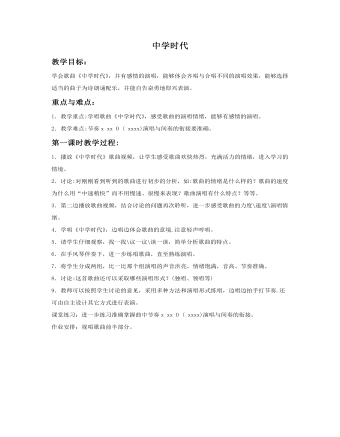
《中学时代》教案
第一课时教学过程:1.播放《中学时代》歌曲视频,让学生感受歌曲欢快热烈,充满活力的情绪,进入学习的情境。2.讨论:对刚刚看到听到的歌曲进行初步的分析,如:歌曲的情绪是什么样的?歌曲的速度为什么用“中速稍快”而不用慢速、很慢来表现?歌曲演唱有什么特点?等等。3.第二边播放歌曲视频,结合讨论的问题再次聆听,进一步感受歌曲的力度\速度\演唱情绪。4.学唱《中学时代》,边唱边体会歌曲的意境.注意轻声哼唱。5.请学生仔细观察,找一找\议一议\谈一谈,简单分析歌曲的特点。6.在手风琴伴奏下,进一步练唱歌曲,直至熟练演唱。7.将学生分成两组,比一比那个组演唱的声音洪亮,情绪饱满,音高、节奏准确。8.讨论:这首歌曲还可以采取哪些演唱形式?(独唱、领唱等)9.教师可以按照学生讨论的意见,采用多种方法和演唱形式练唱,边唱边拍手打节奏.还可由自主设计其它方式进行表演。课堂练习:进一步练习准确掌握曲中节奏x xx 0 ( xxxx)演唱与间奏的衔接。作业安排:视唱歌曲前半部分。
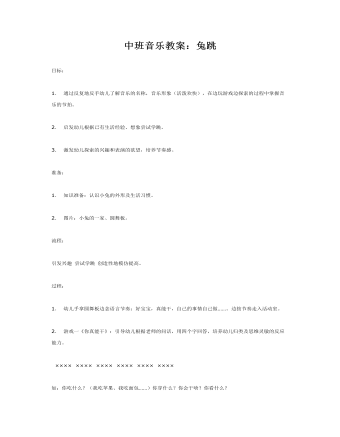
中班音乐教案:兔跳
2. 启发幼儿根据已有生活经验、想象尝试学跳。3. 激发幼儿探索的兴趣和表演的欲望,培养节奏感。准备:1. 知识准备:认识小兔的外形及生活习惯。2. 图片:小兔的一家、圆舞板。流程:引发兴趣 尝试学跳 创造性地模仿提高。
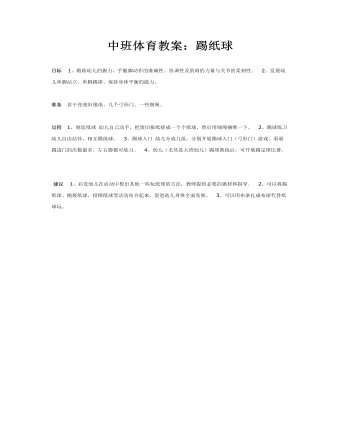
中班体育教案:踢纸球
2、发展幼儿单脚站立、单脚踢球、保持身体平衡的能力。 准备 若干张废旧报纸、几个弓形门、一些细绳。 过程 1、制造纸球幼儿自己动手,把废旧报纸搓成一个个纸球,然后用细绳捆绑一下。

